Middle-Eastern Eggplant Casseroles also known as Fatet Batinjan فتت بيتنجان or Fatet Makdous فتيت مكدوس
Batinjan بيتنجان او باذنجان which stands for eggplant in the Arabic language. Some also call the dish Fatet Makdous مكدوس which also stands for pickled eggplants. Fatet or Fateh فته stands for shredded bread which is very common in Middle-Eastern cuisine for you can also find several dishes that start with Fateh or Fatet like: Fatet Jaj (Chicken Fatteh), Fatet Hummus.. those are the ones I am familiar with, and find them all DELICIOUS.
History of Eggplants
The first known written record is found in an ancient Chinese agricultural treaties completed in 544. It was introduced throughout the Mediterranean area by the Arabs in the early Middle-Ages. A book on agriculture by Ibn Al-Awwam in 12th century Arabic Spain described how to grow Eggplants (Aubergines). Eggplants were considered poisonous for a time period. But obviously today, eggplants are favored by many.
Eggplants are considered a fruit and are related to Tomatoes and Potatoes. The number one production country for Eggplants is China, followed by India and Iran. 4th country is Egypt, 5th is Turkey and 7th is Iraq.
Nutrition Benefits
Eggplant is low in fat, protein and carbohydrates. It is also low in Vitamins and minerals. A study in Brazil found eggplant juice to significantly reduce weight, plasma cholesterol levels aortic cholesterol content. Funny enough, eggplant is considered the richest in nicotine concentration, an average of 9Kilos of eggplants is equal to the same amount of nicotine in one cigarette. Eggplant skin has nasunin which is an antioxidant that protects cell membrane from damages.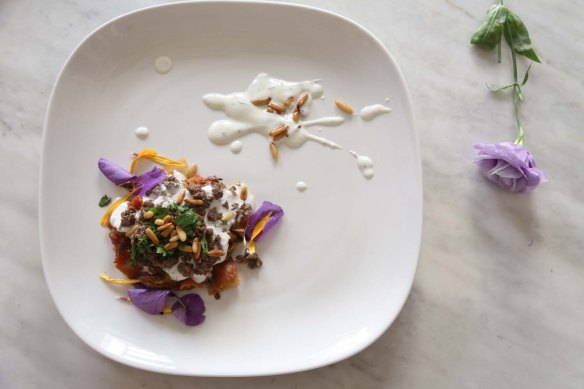
Different ways in making Fatet Bitinjan
I find it inspiring and amazing how many different ways there are to making Fatet Bitinjan, First it is considered to be a Middle-Eastern dish, yet I found it very difficult to track it back to its origin. Is it a Syrian cuisine? Lebanese? Palestinian? Nonetheless it is for sure served in almost every Arab home, and how it is prepared is different from one kitchen to another. Some cut the eggplants into pieces, and scramble them with the tomatoes, some keep the shape of the eggplant, empty its filling and add the ingredients as a filling, some add onion, and others add some other ingredients.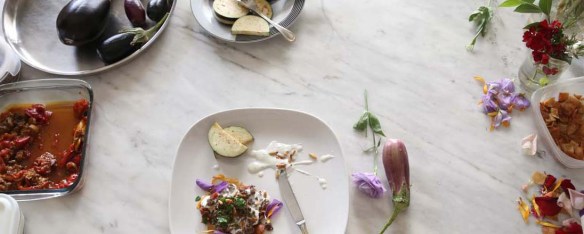
As for SUZIE|S KITCHEN – Fatet Batinjan is a ritual during the holy month of Ramadan, and when it is prepared, we look forward for Iftar Time. It is also very easy to prepare and I think no matter where your from, and if you have tried it before or not, this recipe is worth the try. Bon Appétit | Sahtein
———-
While you are at the recipe, enjoy some Middle Eastern Music
Tip: I suggest you read the recipe and multi task, since each ingredient is prepared separately and then finally combined.
SUZIE|S KITCHEN
Makes enough for 6 to 8 people – 1hr 1/2 total time required
Ingredients
2 pita bread
11/4 cup of sunflower oil
4 medium sized eggplants
6 Tomatoes
1 tablespoon pomegranate molasses
1 tablespoon tomato paste
1 table spoon salt
4 cloves of garlic (crushed)
5 tablespoon olive oil
1 tablespoon crushed dried mint
2 cups of yogurt
1/2 kilo minced meat خشنه
Pinch of mixed pepper
Pinch of black pepper
1 tablespoon roasted pine-nuts
1 tablespoon roasted almonds
2 Tablespoon of finely chopped parsley.
Recipe
Fried Bread
-
Cut the pita bread into small square pieces.
-
In a saucepan over high heat, add 1 cup of sunflower oil and leave to heat for 3 minutes.
-
Lower the heat to medium and add the pieces of bread into saucepan.
-
Leave the bread to fry around 3 – 5 minutes, once you see the bread turn golden, remove saucepan from heat.
-
Leave fried bread on the side.
Eggplants
-
Peel the skin off the eggplants, and cut into medium sized squares.
-
Add the squares of eggplant into a strainer over a bowl and add 1 table spoon of salt over them.
-
Leave the eggplants and keep shaking the strainer every 10 minutes to move the salt around and help the eggplant water drip.
-
Keep doing this for 1/2 hour until the eggplant water have dripped out.
-
Heat your oven for 10 minutes over heat of 360.
-
Get a cooking dish and add 1/4 cup of sunflower oil to it.
-
Add the cooking dish with the oil in the oven for 10 minutes to heat the oil.
-
After 10 minutes, add the eggplant pieces into the dish and leave in the oven for 1/2 hour.
-
Eggplants should be golden, flip them to the other side and add for another 1/2 hour.
-
Remove eggplants from the oven and leave on the side.
Tomatoes
-
In a bowl, add boiling water over the 6 tomatoes and leave for 10 minutes to soak.
-
Tomatoes skin will start peeling, this is when you peel off the skin and cut the tomatoes into small pieces.
-
In a sauce pan, add the tomatoes first then the eggplants over the tomatoes, pomegranate molasses, tomato paste and and leave to boil for 20 minutes.
Yogurt
-
In a separate frying pan over medium heat add the garlic, 3 tbspoon olive oil, and crushed mint and stir until the color turns yellowish.
-
Add a pinch of salt stir a little bit more and remove from heat.
-
In a bowl, add yogurt and the mixed garlic and mix well.
Minced meat
-
In a frying pan, add 2 tbspoon of olive oil, and the minced meat over.
-
Add 1/2 teaspoon of salt, a pinch of black pepper and mixed pepper.
-
Stir the meat until the color is changing into cooked meat. This should take 15 minutes.
SUZIE|S SPECIALITY is to treat fatet batinjan like Fajita, each ingredient in separate dishes and is made for each guest separately to be immediately served. This is to avoid having the fried bread become soaked and soft. The best part about this fateh is having the fried bread crunch in your mouth.
Steps to making your dish of Fatet Batinjan
Step 2: Sprinkle fried bread as a base.
Step 3: Add the tomato eggplants on top of the fried bread.
Step 4: Add yogurt.
Step 5: Add minced meat.
Step 6: Add parsley.
Step 7: Add roasted pine-nuts & almonds.
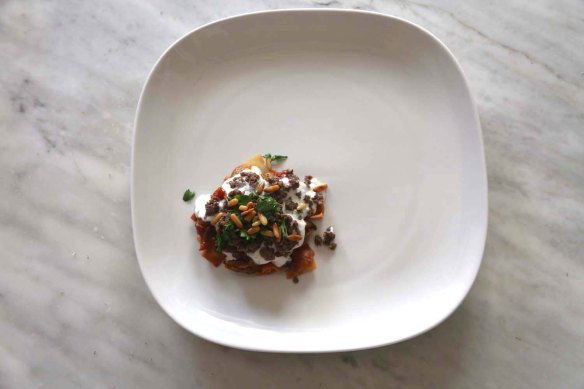 Enjoy your meal and share your comments when you try this recipe. Sahtein
Enjoy your meal and share your comments when you try this recipe. Sahtein

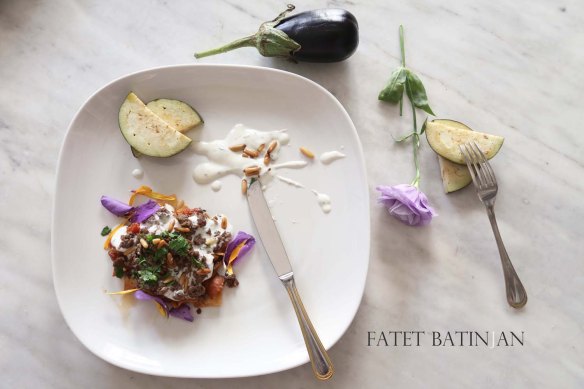
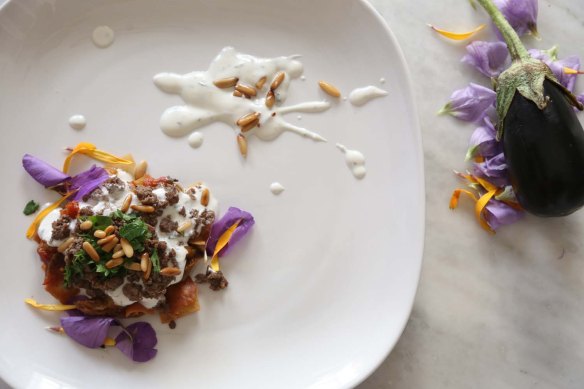











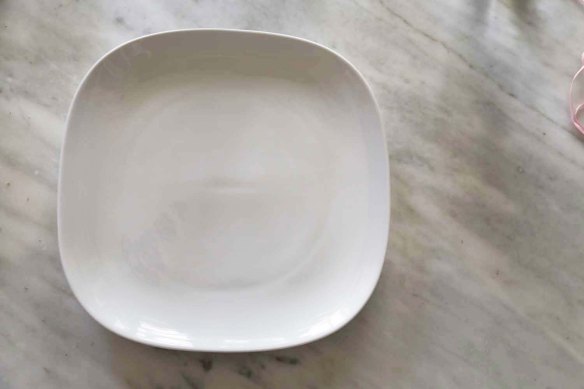
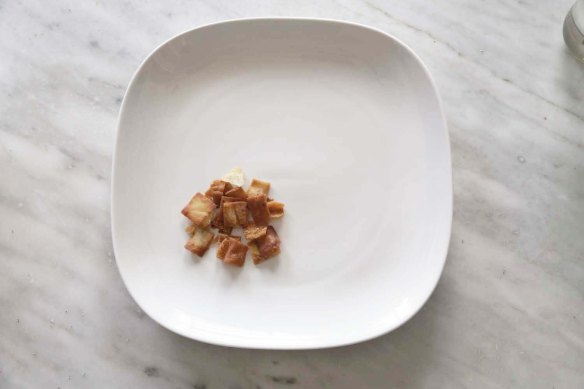


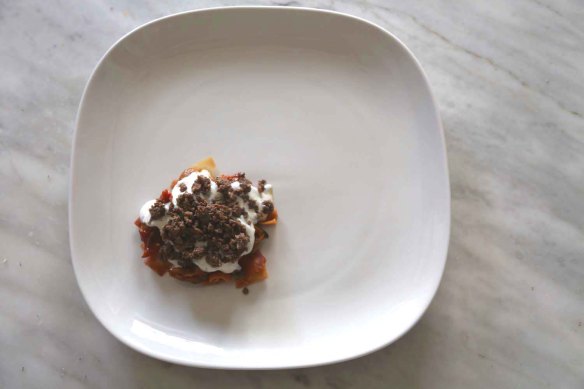

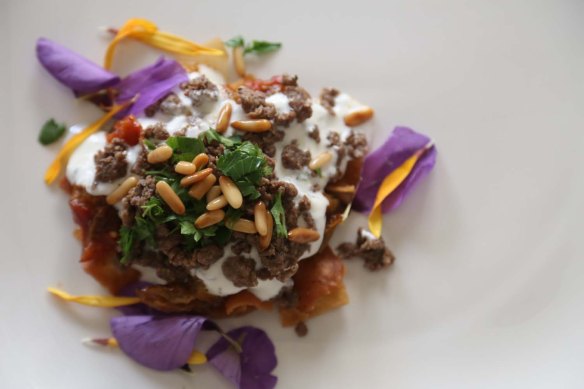
Pingback: Fatet Batinjan | Makdous | My Blog
This dish looks absolutely beautiful!
LikeLike
Give it a try 🙂 Xx
LikeLike
Looks dellllious very good presentation will try it soon inshallah
LikeLike
Thank you 🙂 let me know when you do, would love to hear feedback.
LikeLike
Your recipe Makes My Mouth Water just by looking at it 😋😋😋
Razan
I love your blog it’s rich , have lots of interesting subjects and even it’s helpful with the most delicious plates ..
Your way of food presentation is so creative and original
The way in providing the creativity of the recipes with a delicate touch that I had never seen before and great thanks to the magical fingertips who made and cooked these fine selected recipes..
LikeLike
Your comment is what I look forward to 🙂 thank you so much for your kind words, I hope you try some of the recipes and keep visiting my blog. 🙂 🙂
LikeLike
Dear Razan,
What a beautiful presentation of the Fatet. Photography is amazing and that makes us Arab Women proud of your achievement. I will give you my way which adds flavor in my opinion. I do cut lots of Onion into wedges and few (4-6) cloves of garlic. Saute them in the olive oil, then add the tomatoes and tomato paste with water, boil till water is reduced; add little bit of Chili powder and dash of cinnamon. When eggplants are ready, add them on top of the tomato/onion mixture. When serving, especially when you have a big gathering, I place the tomato/eggplant mixture in the middle of the plate, pour the yogurt with the salt over the whole mixture, then arrange the fried bread around the plate. Garnish with fried pine nuts and then fresh parsley. Try this for the flavor of the garlic and onion is amazing.
Keep up the good work. I will follow your blog and enjoy your recipes.
LikeLike
Dear Zahra,
Your words are so beautiful they are what I truly look forward to receive,
Thank you very much for sharing your tips and recipe I will for sure try it one day.
I will also be uploading some new recipes very soon.
Thank you one more time for your kindness 🙂 And will be happy to read more
Blessings sent your way
LikeLike
Hello Razan,
Amazing! I am defiantly going to try this.. looks delicious and I thank you for the simple yet detailed recipe – impressive!
Since I’ve recently discovered my great passion towards cooking, I have been reading lots of recipes online, but honestly, nothing has amazed me the way your blog – food recipes did.
Keep up the great work and will defiantly let you know once I try your mouth watering dishes.
Zein 🙂
LikeLike
This is one of my favorite comments ever… Thank you for sharing your thoughts and appreciation… Please let me know when you try i am very excited to hear about the turn out.
LikeLike
Pingback: Here is how to make Chicken Fatteh; a delicious Middle-Eastern dish. طريقة عمل فتة الدجاج | Razan Masri
Pingback: Where you can enjoy a Cooking Class and a good meal in Amman, Jordan? | Razan Masri
Got to get eggplant:) lovely recipie and not too difficult to make. Thank You !
LikeLike
We just finished making makdous and I can’t wait to try them. Your recipe looks amazing, as does your presentation skills!
LikeLike